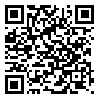Volume 5, Issue 4 (12-2016)
JCP 2016, 5(4): 591-602 |
Back to browse issues page
Download citation:
BibTeX | RIS | EndNote | Medlars | ProCite | Reference Manager | RefWorks
Send citation to:



BibTeX | RIS | EndNote | Medlars | ProCite | Reference Manager | RefWorks
Send citation to:
Jafari M, Minaei S, Safaie N, Torkamani-Azar F, Sadeghi M. Classification using radial-basis neural networks based on thermographic assessment of Botrytis cinerea infected cut rose flowers treated with methyl jasmonate. JCP 2016; 5 (4) :591-602
URL: http://jcp.modares.ac.ir/article-3-9129-en.html
URL: http://jcp.modares.ac.ir/article-3-9129-en.html
1- Department of Bio-System Mechanic Engineering, Faculty of Agriculture, Tarbiat Modares University, Tehran, Iran.
2- Department of Plant Pathology, Faculty of Agriculture, Tarbiat Modares University, Tehran, Iran.
3- Department of Electrical Engineering, College of Electrical and Computer Engineering, Shahid Beheshti University, Tehran, Iran.
4- Department of Horticultural Sciences, Faculty of Agriculture, Tarbiat Modares University, Tehran, Iran.
2- Department of Plant Pathology, Faculty of Agriculture, Tarbiat Modares University, Tehran, Iran.
3- Department of Electrical Engineering, College of Electrical and Computer Engineering, Shahid Beheshti University, Tehran, Iran.
4- Department of Horticultural Sciences, Faculty of Agriculture, Tarbiat Modares University, Tehran, Iran.
Abstract: (3305 Views)
Many environmental and physiological factors affect plant temperature. The objective of this study was to use thermal imagery to investigate robust features for early diagnosis of Botrytis cinerea infection in cut rose flowers under the postharvest application of Methyl Jasmonate (MeJA). Three cases treated with different concentrations of MeJA (0.1, 0.2, and 0.3 µl.l−1), a control (0 µl.l−1 MeJA) and an ethanol-treated case (20 µl.l−1 ethanol) were considered as five treatments in this study. Infrared images of MeJA-treated and non-treated flowers were captured during five consecutive days. Eight days after inoculation, disease severity in all concentrations of MeJA was significantly lower than that of control and ethanol treatments. Maximum temperature difference (MTD) index and median temperature could be used to diagnose the existence and growth of fungal pathogen, at least a day before any significant visual symptoms appear. To identify some robust features for classifying the infected and non-infected flowers, analysis of temperature frequency distribution was implemented. Laplace and normal distributions were considered as the best fitted probability distributions based on the shape of thermal histograms. Parameters of normal and Laplace probability density functions were estimated and the most effective attributes were selected. A radial-basis-function neural network with 60 neurons in the hidden layer was designed to classify and distinguish the infected flowers from the healthy ones. Results showed that the network can classify the infected and non-infected flowers with a 96.4% correct estimation rate.
Article Type: Full Paper |
Subject:
Plant Disease Management
Received: 2015/11/29 | Accepted: 2016/02/20 | Published: 2016/12/29
Received: 2015/11/29 | Accepted: 2016/02/20 | Published: 2016/12/29
| Rights and permissions | |
 |
This work is licensed under a Creative Commons Attribution-NonCommercial 4.0 International License. |








